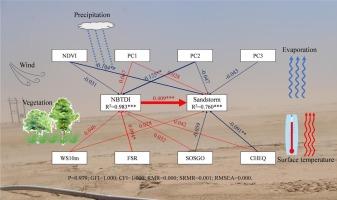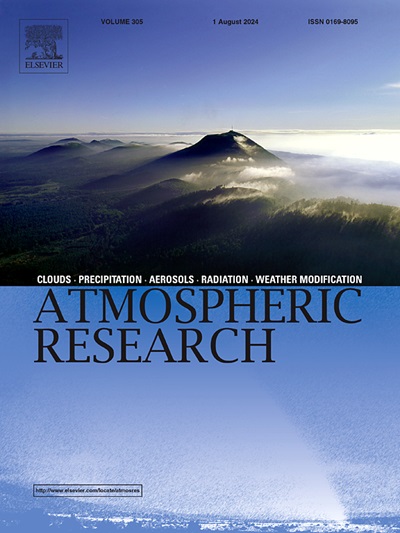Quantifying the influence of dominant factors on the long-term sandstorm weather - A case study in the Yellow River Basin during 2000–2021
IF 4.5
2区 地球科学
Q1 METEOROLOGY & ATMOSPHERIC SCIENCES
引用次数: 0
Abstract
Sandstorm is a disastrous weather phenomenon that often occurs in arid and semi-arid areas, endangering the ecological environment and affecting people's lives and property safety seriously. Since the 21st century, the sandstorm weather in the Yellow River Basin has ameliorated obviously. However, the causes of the long-term trends in sandstorms during 21st century were still unknown. In this study, fifteen influencing factors from five aspects: ecology, meteorology, hydrology, geography and man-made were selected to comprehensively analyze the driving mechanism of sandstorm activities in the Yellow River Basin since the 21st century, and the effect of each influencing factor on sandstorm weather was quantified. The results indicated that ecological, meteorological and geographical factors had dominant impacts on the spatio-temporal variation of sandstorms during 2000–2021, while hydrological and human factors played little role in the long-term variation of sandstorms. Sandstorms frequently occurred in semi-desert or grassland or non-high vegetation covered areas in spring. Vegetation coverage, precipitation, surface pressure, surface roughness, and soil moisture content were negatively correlated with sandstorms, while wind speed, friction velocity, evaporation, and soil temperature were positively correlated with sandstorms. Precipitation, runoff, evaporation, soil moisture content, soil temperature, and surface temperature indirectly acted on normalized brightness temperature dust index (NBTDI) and sandstorms by changing soil texture. Normalized Vegetation Index (NDVI) had direct negative effects on NBTDI, while wind speed 10 m (WS10m), slope of sub-gridscale orography (SOSGO), and forecast surface roughness (FSR) had direct positive effects on NBTDI. This study comprehensively revealed the dominant factors and their driving mechanism of sandstorm weather in the Yellow River Basin since the 21st century, which had practical application value for the prevention of sandstorms.

量化主导因素对长期风沙天气的影响--2000-2021 年黄河流域案例研究
沙尘暴是干旱半干旱地区经常出现的灾害性天气现象,严重危害生态环境,影响人民生命财产安全。进入 21 世纪以来,黄河流域风沙天气明显好转。然而,21 世纪沙尘暴长期趋势的成因尚不清楚。本研究从生态、气象、水文、地理和人为五个方面选取了 15 个影响因子,全面分析了 21 世纪以来黄河流域沙尘暴活动的驱动机制,并量化了各影响因子对沙尘暴天气的影响。结果表明,生态、气象和地理因素对 2000-2021 年沙尘暴的时空变化具有主导影响,而水文和人为因素对沙尘暴的长期变化作用不大。春季沙尘暴多发生在半荒漠或草原或植被覆盖率不高的地区。植被覆盖率、降水量、地表压力、地表粗糙度和土壤含水量与沙尘暴呈负相关,而风速、摩擦速度、蒸发量和土壤温度与沙尘暴呈正相关。降水、径流、蒸发、土壤水分含量、土壤温度和地表温度通过改变土壤质地间接影响归一化亮度温度沙尘指数(NBTDI)和沙尘暴。归一化植被指数(NDVI)对归一化亮度温尘指数(NBTDI)有直接的负面影响,而 10 米风速(WS10m)、子网格尺度地形坡度(SOSGO)和预报表面粗糙度(FSR)对归一化亮度温尘指数(NBTDI)有直接的正面影响。该研究全面揭示了 21 世纪以来黄河流域沙尘暴天气的主导因子及其驱动机制,对预防沙尘暴天气具有实际应用价值。
本文章由计算机程序翻译,如有差异,请以英文原文为准。
求助全文
约1分钟内获得全文
求助全文
来源期刊

Atmospheric Research
地学-气象与大气科学
CiteScore
9.40
自引率
10.90%
发文量
460
审稿时长
47 days
期刊介绍:
The journal publishes scientific papers (research papers, review articles, letters and notes) dealing with the part of the atmosphere where meteorological events occur. Attention is given to all processes extending from the earth surface to the tropopause, but special emphasis continues to be devoted to the physics of clouds, mesoscale meteorology and air pollution, i.e. atmospheric aerosols; microphysical processes; cloud dynamics and thermodynamics; numerical simulation, climatology, climate change and weather modification.
 求助内容:
求助内容: 应助结果提醒方式:
应助结果提醒方式:


